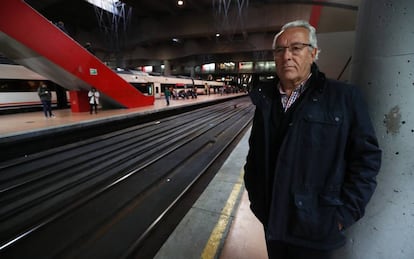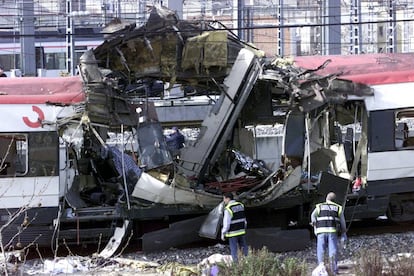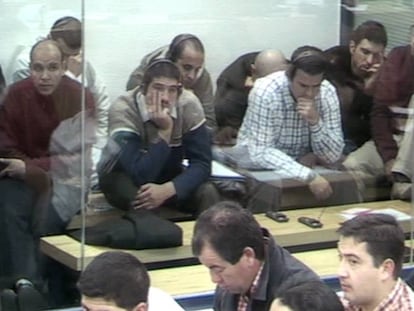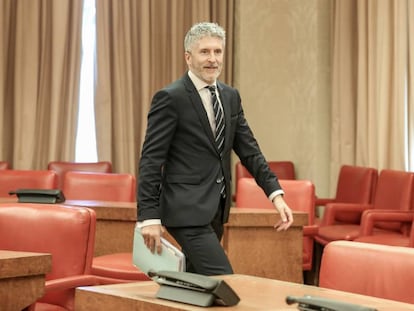“The government asked me to accept their lie about the Madrid train bombings”
Former police chief Juan Jesús Sánchez Manzano was the head of Spain’s Tedax bomb squad when the 2004 jihadist massacre took place in Madrid. Now retired, he tells his side of what became the biggest “fake news” story the country has ever suffered


Retired police superintendent Juan Jesús Sánchez Manzano, 65, arrives on time to his interview with EL PAÍS in Madrid’s Atocha train station, one of the main scenes of the bombings that took place in the Spanish capital on March 11, 2004. At the time of the attack, Manzano was the head of Spain’s Tedax bomb-disposal unit, and, in the wake of the massacre, which killed 193 people and left nearly 2,000 injured, became caught up in what he describes as the “huge lie” that was forged by the then-Popular Party government of Prime Minister José María Aznar. The worst terrorist attack to ever take place on Spanish soil was initially blamed by the government on Basque separatist group ETA, despite evidence collected by Manzano’s teams suggesting otherwise. As the truth came out, namely that a jihadist cell had carried out the atrocity, the public turned against the PP government, in large part because Spain had supported the United Kingdom and the United States in launching the 2003 war in Iraq. The PP promptly lost the general election that was held just three days later to the Socialist Party (PSOE). Having retired in October, Manzano is now prepared to offer his full side of the story.
Question. At what time on March 11, 2004, were you sure that the bombings were a jihadist attack and had nothing to do with Basque terrorist group ETA?
Answer. By 3pm on the 11th itself. That was when the Kangoo van used by the terrorists was inspected, and remains of [explosive] Goma 2 Eco and some detonators were found. What’s more, a cassette tape was located that contained passages from the Koran in Arabic. That said, there was already evidence that it was a jihadist attack, given that first thing that day, when they found the bombs left in El Pozo and Atocha stations, the Tedax had already discovered that the explosive material was white, not red, like Titadyn dynamite, which is what ETA usually used. They had also already observed and they informed us, in Atocha station itself, that the effect of the explosion was due to a more powerful and faster explosive than Titadyn dynamite.
Apparently, one of the prime minister’s advisors said, ‘If it was ETA, we’ll clean up at the elections, but if it was jihadists, the PSOE will win’
Q. What did you do after those items were found in the van?
A. Inform the general commissioner of Citizen Security [Santiago Cuadro], who was my immediate superior. At the time of the discovery, the general commissioner for Information [Jesús de la Morena] was with me, and he saw the same evidence as I did and he asked the Tedax questions related to the items that had appeared in the van. The technicians informed him that the components and devices there had no relation to what ETA had used previously.

Q. Was that when you put out the idea that it could be a jihadist attack?
A. Yes, with that evidence we started to think about Islamists. Of course, what was ruled out with complete certainty at that point was that ETA was responsible, and that was reported to the police authorities at 3pm on March 11.
Q. How do you explain then, that five hours later, the then-interior minister, Ángel Acebes, would publicly announce that the main theory was ETA, albeit without ruling out other possibilities?
A. That was what Acebes told the public in the evening, but beforehand, at 7.35pm, the government of [Popular Party Prime Minister José María] Aznar had sent out to embassies and international organizations a telegram signed by the then-foreign minister, Ana Palacio, in which she explicitly apportioned the blame for the attack with ETA, and called on ambassadors to keep to that theory. There was no need to signal blame at that point.
Q. Why do you think that the Spanish government wanted to get that message out abroad, in contrast to the information that was being sent by the police?
A. I don’t know, I won’t venture an opinion on that. It surprised me a great deal, my wife told me about it at 1am on the 12th when I got home. She had heard the news. Shortly afterward, the Tedax called me to tell me that they had found another bag with a bomb in it at Puente de Vallecas. I don’t know the aim of that international statement, which bore no relation to the data about our discoveries and theories.
Q. How and when do you believe that the lie began?
A. According to what was published in the media afterwards, it was in La Moncloa [the seat of the Spanish government]. March 11 was a Thursday, and there was a general election on the Sunday. Apparently, one of the prime minister’s advisors said: “If it was ETA, we’ll clean up, but if it was jihadists, the PSOE will win.” As soon as they started talking in those terms in La Moncloa, the statements blaming ETA began.
Q. How many times on March 11 do you remember having spoken to your superiors about how it couldn’t have been ETA?
A. From 1pm onward, when the general superintendent for Citizen Security arrived at the Tedax unit, and spoke to the chemical inspector from the laboratory and other Tedax agents, they told him that what had been seized so far did not point to ETA. They told him they couldn’t determine the class of explosive, only that it was dynamite, and that it was faster than that usually used by the terrorist group, given the effect the explosions had on the trains. That was confirmed later on, when they found detonators and remains of Goma 2 ECO dynamite in the van. At that point, at 3pm on the 11th, I relayed this to my general superintendent of Citizen Security and to the general superintendent of Information [Jesús de la Morena] […] In front of me, he made the call to inform the secretary of state, Ignacio Astarloa.
Q. What did you think when you knew that those telegrams had been sent to embassies and international organizations?
A. As they let me know at that time, at around 1am, of the discovery of a bag with an explosive device in it at the Puente de Vallecas police station, I had to immediately go to [Madrid suburb] Vallecas. On the way I was thinking that someone would have to justify that telegram and the statements made by the interior minister, in which he blamed ETA for the attacks. They would need a scapegoat, and the most opportune person was me, given that I was the head of Tedax. So, when I got to Puente de Vallecas, the first thing I did was to order the section chief to get the head of the reporting group to put together a log of all the activities and communications from the unit: informative notes and documents, everything. That’s what they did until June 23, when that log was closed, it was registered officially and sent to the general superintendent for Citizen Security and the general director of the police [Agustín Díaz de Mera]. Everything that was done and all the information that was sent out is in there. That log was our safeguard.
Q. But they called on you for explanations.
A. Days before the investigative commission began in [Spain’s lower house,] the Congress of Deputies, at the beginning of July, higher authorities from the Aznar government called on me to accept that the Tedax had used the word “Titadyn” – the one that ETA usually used – as the explosive used in the 11-M attack. That way the government could justify its error. That was never the case.
Q. Who would you say fed the lie?
A. I have no idea. It is true to say that as the parliamentary investigative commission approached, some journalists, such as [then editor-in-chief of El Mundo] Pedro J. Ramírez, [then-head of news at El Mundo] Casimiro García-Abadillo, and [journalist for right-wing media outlets] Jiménez Losantos, began to circulate theories to try to maintain a relationship between the attacks and ETA. They were creating what were later to be called the “conspiracy theories.” They went as far as to say that I had the rucksack that contained the bomb found in Puente de Vallecas in my kitchen. The aim was to make it look as if the police were behind a conspiracy against the Aznar government. An outlandish idea that they insisted on for 10 years and that was based on the actions of the Tedax, other police units and also the public prosecutor and the judiciary.
Q. Would you say that the government of the time used 11-M to create one of the biggest “fake news” stories in the history of Spain?
A. Yes, that is the great lie that was propagated by certain journalists, and, what’s more, we have seen the consequences: tensions in society, which ended up divided, and they also divided the victims, offending them by not respecting their grief. That campaign, which was orchestrated by certain media outlets, saw the PP lose the elections again in 2008.
Q. What would you say to one of those victims today, 15 years later?
A. What I’d like them to know is that we worked incredibly hard and with rigor. None of the Tedax officers let up for a minute and they contributed to solving the situation in an agile and efficient manner. The sad thing is that the police couldn’t avoid the attack from taking place at all.
English version by Simon Hunter.
Tu suscripción se está usando en otro dispositivo
¿Quieres añadir otro usuario a tu suscripción?
Si continúas leyendo en este dispositivo, no se podrá leer en el otro.
FlechaTu suscripción se está usando en otro dispositivo y solo puedes acceder a EL PAÍS desde un dispositivo a la vez.
Si quieres compartir tu cuenta, cambia tu suscripción a la modalidad Premium, así podrás añadir otro usuario. Cada uno accederá con su propia cuenta de email, lo que os permitirá personalizar vuestra experiencia en EL PAÍS.
¿Tienes una suscripción de empresa? Accede aquí para contratar más cuentas.
En el caso de no saber quién está usando tu cuenta, te recomendamos cambiar tu contraseña aquí.
Si decides continuar compartiendo tu cuenta, este mensaje se mostrará en tu dispositivo y en el de la otra persona que está usando tu cuenta de forma indefinida, afectando a tu experiencia de lectura. Puedes consultar aquí los términos y condiciones de la suscripción digital.
More information
Archived In
Últimas noticias
Maduro pleads not guilty before the federal court in New York: ‘I am still the president of Venezuela’
A new test can detect Alzheimer’s from a finger prick
UN team enters Sudanese city of El Fasher after paramilitary massacre: ‘It’s like a ghost town’
A recipe for resistance: Indigenous peoples politicize their struggles from the kitchen
Most viewed
- Gilles Lipovetsky: ‘If you want to live better and fall in love, take Prozac, don’t look to philosophy’
- Alain Aspect, Nobel laureate in physics: ‘Einstein was so smart that he would have had to recognize quantum entanglement’
- Alvin Hellerstein, a 92-year-old judge appointed by Bill Clinton, to preside over Maduro’s trial in New York
- Why oil has been at the center of Venezuela-US conflicts for decades
- Cuba confirms death of 32 of its citizens in the US attack against Venezuela










































